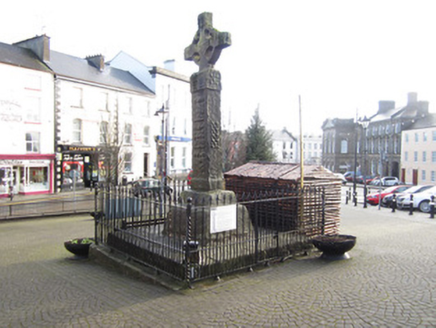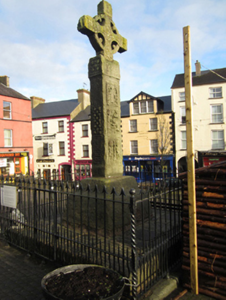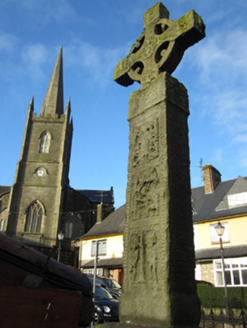Survey Data
Reg No
41304037
Rating
National
Categories of Special Interest
Archaeological, Artistic, Cultural, Historical, Social, Technical
Original Use
Monument
In Use As
Monument
Date
825 - 875
Coordinates
250159, 325878
Date Recorded
19/12/2011
Date Updated
--/--/--
Description
Free standing sandstone cross, dating to mid-ninth century, consisting of head of one cross and shaft of another, with stepped stone base. South-west face of shaft bears iconography depicting 'Daniel in the Lions' Den' at top of shaft with immediately below it 'The Sacrifice of Isaac' and below that 'Adam and Eve/The Fall of Man'. North-west face of shaft bears 'The Adoration of the Magi', 'The Wedding at Cana' and 'The Multiplication of the Loaves and Fishes'. Beaded decoration runs up sides of the two faces and also around distinctive collar at top of shaft. Head of cross, which was added at much later date, has crucifixion scene with unidentified scene below it on north-west side. At centre of south-west of head is another depiction of 'Daniel in the Lions' Den', with 'Cain slaying Abel' to left and possibly 'Pilate washing his hands' to right. East and west sides of cross have bosses and interlaced decoration. Cross stands to height of 4.57m, on stepped stone-built platform with wrought-iron railings having barley-sugar twisted square pillars to four corners and arrow-topped balusters between with lower rail resting on turned cast-iron feet around entire monument.
Appraisal
The two fragments which make up this cross were among the remains of a monastery founded in Clones by Saint Tighearnach in the sixth century and is part of the important Ulster group of high crosses. The cross itself and the various biblical scenes depicted served as a scripture in stone. The quality of the carving is very high and the inclusion of geometric, as well as figure, ornament was typical of such crosses. Clearly the continued presence of this monument, which is well over a thousand years old, as a publicly accessible artifact at the heart of the town is a sign of the local regard for this rare piece of monumental stone sculpture that contributes immensely to the cultural heritage and identity of the town and the broader region of south Ulster.





